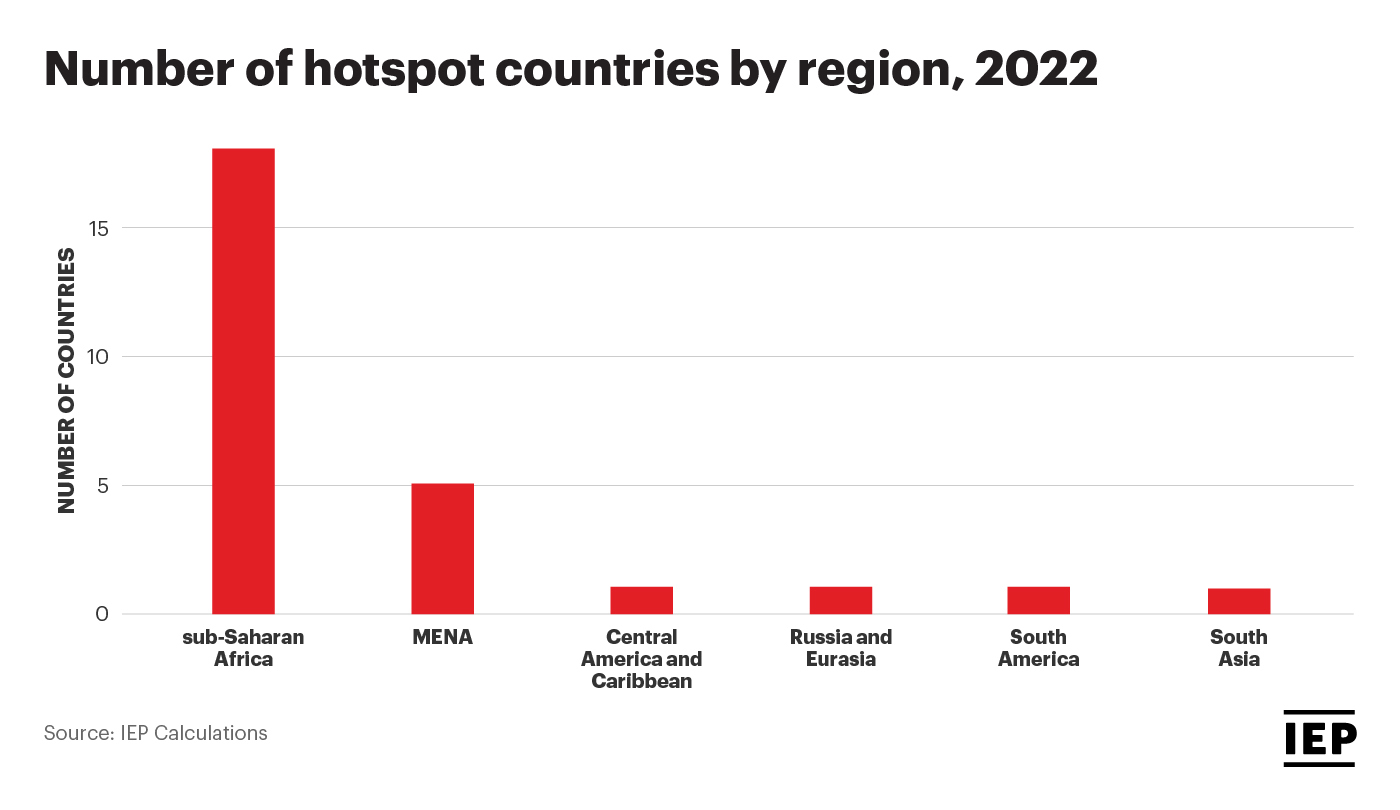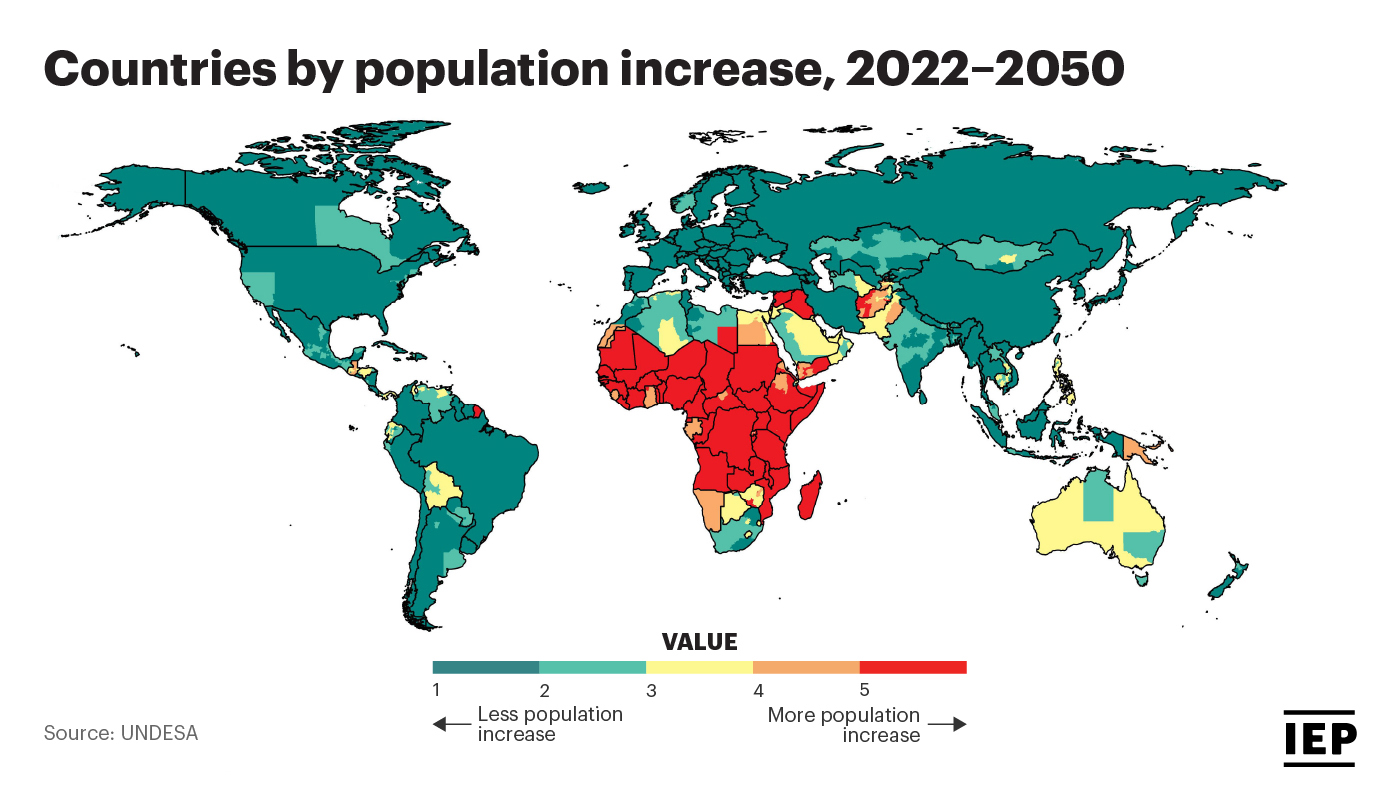Despite accounting for less than 4% of greenhouse gas emissions, sub-Saharan Africa is bearing the brunt of the impacts of climate change. This hugely populous region is particularly vulnerable, having the highest threat score of any region in the world.
IEP’s latest Ecological Threat Report (ETR) measures ecological threats in 228 independent states and territories and provides projections to 2050. The results of this year’s ETR shine a spotlight on the complex and compounding threats facing the region of sub-Saharan Africa.
No region is as vulnerable as sub-Saharan Africa to the threats of water scarcity, food insecurity, population increase and natural disaster threats.
The ETR identifies 27 hotspot countries that face a combination of catastrophic ecological threats and low societal resilience; two thirds of these are located in Sub-Saharan Africa and it is home to seven of the eight most at risk countries.

Understanding why this region is facing such extreme threats is challenging, and there are a number of factors contributing to this insecurity.
Sub-Saharan Africa is the region experiencing the fastest population growth, with the population projected to rise by over 95% to reach 2.1 billion by 2050. All 15 countries with the highest projected population growth for 2050 are in sub-Saharan Africa.

The rapid population growth has also triggered massive urbanisation. Cities including Nairobi, Lagos and Khartoum among others are projected to increase by between 80 and 100%.
This rapid expansion places additional stress upon already limited resources and can intensify competition and conflict. This has given rise to informal urban settlements and led to the destruction of farmland and green spaces.
Economies in sub-Saharan Africa are highly reliant on agricultural exports, with this on average accounting for 65% of their GDP. The majority of sub-Saharan African economies are dependent on rain-fed agriculture, which are particularly vulnerable to changes in climatic conditions (such as prolonged droughts and seasonal floods which have increasingly impacted the region). Furthermore, 21 sub-Saharan African countries rely on food imports from low peace countries.
The recent increase in global food insecurity has been rapid and nowhere has felt this more keenly than sub-Saharan Africa. Of the 52 countries within sub-Saharan Africa, 37 recorded extremely high levels of food insecurity. The region has the highest levels of food insecurity in the world with 67% of the population impacted. This has been compounded by recent supply shocks, such as the COVID-19 pandemic and the Russian invasion of Ukraine.
On top of these broader problems, sub-Saharan Africa has also faced unique issues in recent years such as the absence of volcanic rejuvenation, cycles of weathering and erosion. These issues have left the soil in sub-Saharan Africa inherently low in nutrients and compound existing agricultural problems.
Water insecurity is also a major threat, with sub-Saharan Africa again being the most impacted region. Severe droughts and water insecurity have the potential to undermine agricultural practices and trigger conflict.
Nigeria is currently experiencing its worst floods in over a decade and this is not an anomaly. Sub-Saharan Africa has notably been experiencing increasingly high-levels of damaging natural disasters, in particular, more floods as well as more frequent and longer droughts. The region is the second most impacted in the world by natural disasters, with only Asia experiencing a greater number of disaster events.
These events have had enormous impacts on sub-Saharan Africa, destroying infrastructure and causing a significant loss of life. Globally these events are occurring at an increased frequency, with the number of natural disasters reaching 429 in 2021, more than triple the number that occurred in 1981. These events have cost on average $200 billion per annum in the last decade.
While the increase in frequency is a global issue, in areas with low societal resilience such as sub-Saharan Africa, the impacts of disasters are felt much more keenly. IEP’s research shows that natural disasters in countries with low levels of Positive Peace have a fatality rate seven times higher than those with very high levels of Positive Peace.
With ongoing conflicts in Mali, Burkina Faso, Chad and elsewhere sub-Saharan Africa is among the regions with the lowest levels of peacefulness. Peacefulness in sub-Saharan Africa has in fact deteriorated according to the latest Global Peace Index.
This has coincided with an increase in terrorism in the region. With conflict subsiding in Syria, IS and its affiliates have shifted their activities away from the Middle East and towards sub-Saharan Africa and the Sahel. Research from the latest Global Terrorism Index finds that eight of the nine countries most impacted by terrorism are in either South Asia or sub-Saharan Africa.
The region also has the highest average ETR score and there is a strong correlation between ecological threats and peacefulness. This relationship demonstrates that less peaceful countries have a much higher prevalence of threats, particularly those of food insecurity and water stress.
Furthermore, these threats can trigger further vicious cycles of insecurity, such as occurred in Mali throughout 2019 – when feuds over water displaced 50,000 people and led to a series of massacres and an intensification of conflict.
It is not just local conflicts that have had a significant impact on sub-Saharan Africa. Between 2007 and 2019, Africa’s wheat imports rose from 27.3 million tons to 47 million tons to account for the rising population. Much of these imports came from Ukraine, one of the world’s major grain exporters, however, its invasion by Russia has severely impacted both the availability and cost of these imports.
While sub-Saharan Africa is uniquely impacted by a broad range of issues, what makes these challenges so significant is how they intersect and compound one another. Natural disasters, for example, are difficult enough to manage on their own but these events often trigger other threats such as major displacements. Of the internal displacements recorded in 2021, 23.7 million occurred as a direct result of natural disasters.
What becomes apparent, with incidents like the resource conflicts in Mali, is that ecological issues can act as threat multipliers and trigger further conflict. This feeds more displacement, which can in turn lead to further ecological crises and further insecurity. Disrupting these cycles is particularly challenging.
Ecological and humanitarian crises often spill over to adjacent countries and have significant regional implications, potentially destabilising entire regions. These complex problems are compounded when the region doesn’t have the resilience to cope.
In light of the challenging global economic environment, the IMF has predicted sub-Saharan Africa’s economic growth to stagnate further this year and the economic outlook for the region is challenging.[1]
Addressing sub-Saharan Africa’s vulnerability requires more than merely preparing to mitigate ecological or economic threats. For the region to be able to sustainably approach what will certainly be a challenging future, the region must build its resilience.
Resilience building is a deeper and more holistic process, involving engagement or transformation of all aspects of a societal system. Part of this holistic approach is recognising the complex relationships between ecological change, sustainable development, human security and global action.
Faced with such complexity sub-Saharan Africa’s governments, international agencies and aid donors must develop a common understanding of the meaning of ‘resilience’. With the complex issues facing sub-Saharan Africa, only integrated and holistic solutions will be enough to appropriately meet these challenges.